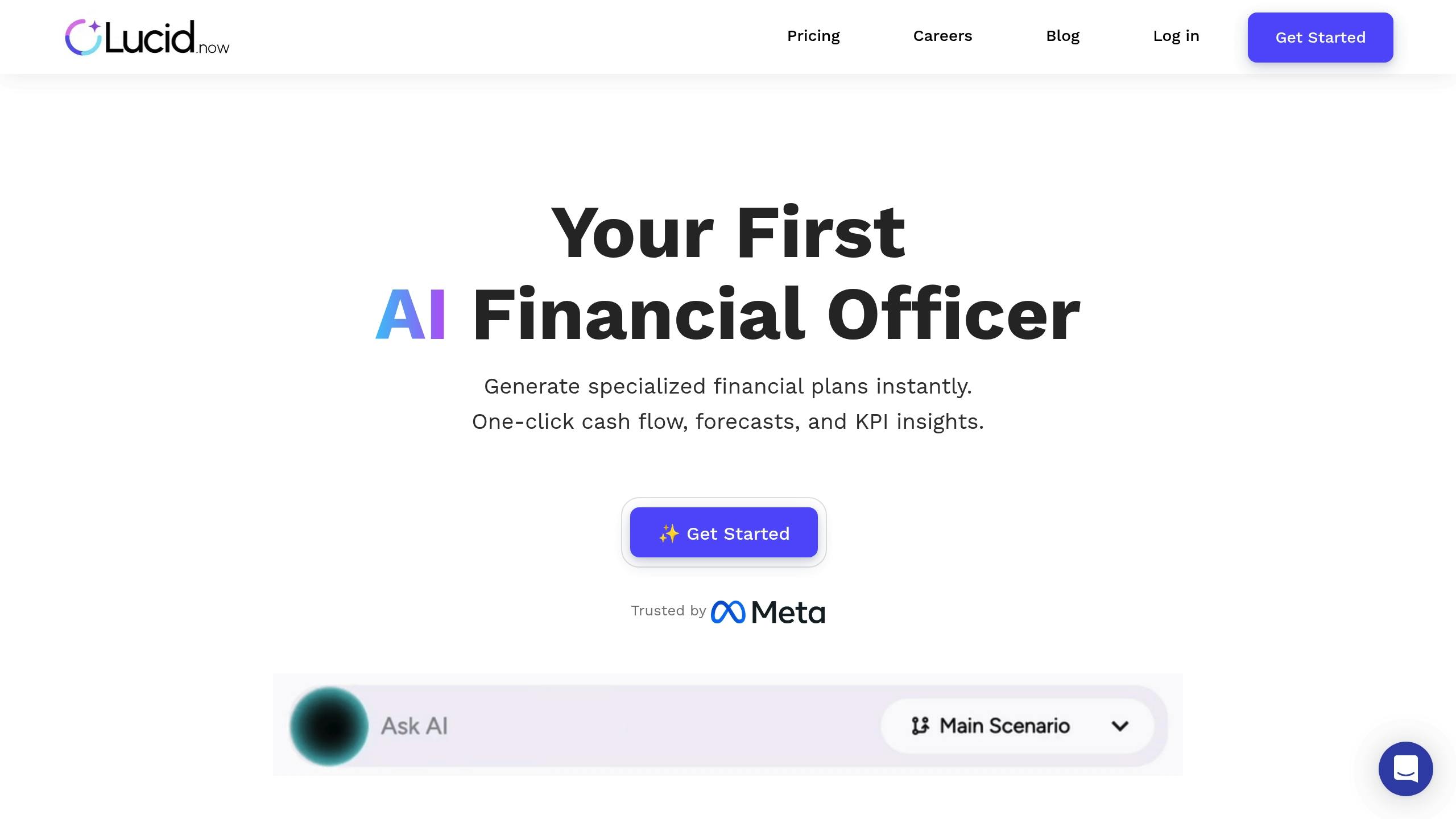AI is transforming how SaaS startups project revenue, making forecasts up to 50% more accurate while reducing errors and saving time. By analyzing patterns, providing real-time updates, and automating complex calculations, AI tools help businesses predict growth, reduce churn, and plan finances more effectively.
Key Takeaways:
- Accuracy Boost: AI improves revenue forecast accuracy by up to 82%.
- Revenue Growth: Companies report a 35% revenue increase using AI insights.
- Churn Reduction: AI predicts churn and identifies high-value customers.
- Automation: Simplifies recurring revenue and customer segmentation calculations.
- Tools to Use: Platforms like Lucid Financials, Baremetrics, and ProfitWell offer tailored solutions for SaaS businesses.
Quick Comparison of AI Tools for SaaS Forecasting
| Tool | Focus Areas | Unique Features |
|---|---|---|
| Lucid Financials | Financial planning | Real-time integration, scenario testing |
| Baremetrics | Subscription analytics | Churn prediction, payment recovery |
| ChartMogul | Cohort and revenue analysis | Advanced subscription insights |
| ProfitWell | Pricing and retention | Free metrics dashboard, price optimization |
AI is no longer optional for SaaS startups - it’s a must-have for staying competitive and scaling efficiently. Start small, integrate with your existing tools, and measure results to refine your approach.
Related video from YouTube
Main Advantages of AI Forecasting
AI-driven revenue forecasting offers powerful benefits for SaaS startups aiming to refine their financial planning. By leveraging advanced technology, three standout advantages make it a must-have for SaaS revenue forecasting:
Data Pattern Analysis
AI is exceptionally good at spotting patterns in complex SaaS revenue data - patterns that might escape even the most skilled analysts. Machine learning algorithms process vast amounts of historical and real-time data to reveal trends in customer behavior, market shifts, and overall business performance.
With these capabilities, SaaS startups can:
- Spot trends in customer acquisition
- Anticipate churn risks
- Account for seasonal variations
- Understand how market conditions affect revenue
This ability to uncover patterns sets the stage for the next advantage.
Live Forecast Updates
Real-time forecast updates are a major improvement over traditional quarterly adjustments. AI systems analyze incoming data continuously, allowing instant updates to forecasts as conditions evolve.
For example, when HubSpot adopted machine learning forecasting, they achieved 35% more accurate revenue predictions by dynamically adjusting to changes in customer behavior [5]. This adaptability helps businesses respond quickly to unexpected events like sudden customer surges or market disruptions.
Automated Financial Calculations
In recurring revenue models, automation powered by AI is especially useful. It simplifies complex calculations and helps businesses stay on top of their numbers.
Key automated calculations include:
| Calculation Type | Function | Impact |
|---|---|---|
| Churn Prediction | Identifies patterns that signal cancellations | Helps mitigate revenue losses |
| Customer Segmentation | Groups users by attributes to forecast revenue potential | Pinpoints high-value customers |
| Recurring Revenue | Monitors MRR/ARR in real time | Enhances cash flow planning |
For instance, Zendesk saw a 20% increase in average contract value by using AI to automate pricing [3]. Additionally, improving customer retention by just 5% can boost profitability by 25% within a year [4]. These tools and insights make a measurable difference for SaaS startups.
Setting Up AI Revenue Forecasting
To make the most of AI's forecasting capabilities, SaaS startups need a structured approach. AI-powered forecasting systems can improve accuracy by up to 50% compared to manual methods [1].
Key Data Points to Collect
AI forecasting relies on gathering data across critical metrics. Here's a breakdown of the key categories and their relevance:
| Metric Category | Key Data Points | Purpose |
|---|---|---|
| Revenue Metrics | MRR, ARPU, Expansion Revenue | Assess recurring revenue health |
| Customer Metrics | CAC, CLV, Churn Rate | Evaluate customer profitability |
| Sales Data | Pipeline stages, Close rates | Predict future revenue |
| Historical Data | Past revenue, Growth trends | Train AI models to identify patterns |
Integrating AI with Existing Business Tools
To ensure accurate and continuous forecasting, link your AI tool with your current business systems. Focus on these key integrations:
-
CRM Systems
Use APIs to connect your AI tool with your CRM. This allows real-time synchronization of customer and sales data, ensuring forecasts stay current. -
Accounting Software
Integrate accounting tools via APIs or pre-built connectors. This streamlines financial data entry and ensures consistency across platforms. -
Marketing Platforms
Link marketing automation tools to track customer acquisition metrics and campaign outcomes. This adds another layer of insight for revenue projections.
Verifying Forecast Accuracy
Consistently checking the accuracy of your AI forecasts is essential. Use these methods to maintain reliability:
- Monthly Checks: Compare predictions with actual results and identify any discrepancies.
- Quarterly Reviews: Reassess the model's assumptions to account for market changes.
- Annual Updates: Adjust baseline metrics and evaluate long-term performance.
These steps will help you refine your forecasts and address potential challenges during implementation.
sbb-itb-17e8ec9
Problems and Solutions in AI Forecasting
AI forecasting offers many benefits, but its implementation comes with challenges. Here’s how to tackle three major issues effectively:
Addressing Limited Data
When historical data is scarce, consider these strategies to improve your models:
| Strategy | How It Works |
|---|---|
| Synthetic Data Generation | Generate artificial data points based on industry trends to train models better. |
| Transfer Learning | Use pre-trained models from similar industries for quicker and more accurate deployment. |
| External Data Integration | Add market indicators or competitor data to provide richer context for forecasts. |
For example, Payflo boosted its forecast accuracy from 65% to 89% by leveraging synthetic data generation (Baremetrics 2024).
Mitigating AI Forecast Bias
AI models can sometimes develop biases, which can distort predictions. To ensure accuracy, focus on these areas:
1. Data Validation
Automate processes to:
- Check for data consistency across sources.
- Detect and handle outliers.
- Identify and fill missing values.
2. Model Diversity
Rely on a mix of forecasting methods to minimize bias. This can include:
- Using ensemble models.
- Applying cross-validation techniques.
- Involving human experts for oversight and review.
Balancing Costs and Benefits: Choosing Tools for Your Growth Stage
With 41% of SaaS companies now monetizing AI features [3], selecting the right forecasting tools is vital. Early-stage startups can explore these budget-friendly options:
| Solution Type | Ideal For |
|---|---|
| Open-source Libraries | Teams with technical expertise in machine learning. |
| Cloud AI Services | Businesses needing flexible scaling options. |
| AI-enhanced Spreadsheets | Basic forecasting tasks without heavy technical requirements. |
Measure the return on investment (ROI) by considering factors like time saved, improved accuracy, reduced errors, and compatibility with existing systems.
"Prioritize data quality checks before model deployment to maximize AI effectiveness" [7]
AI Forecasting Tools for SaaS
AI tools play a major role in SaaS revenue forecasting, building on earlier steps like data integration and validation. These tools turn validated forecasts into actionable insights, helping businesses make informed decisions.
Lucid Financials

Lucid Financials is an AI-driven financial planning platform designed specifically for SaaS companies. It offers a range of features that address key forecasting needs:
| Feature | What It Does |
|---|---|
| Scenario Planning | Simultaneously test multiple growth scenarios |
| Industry Benchmarks | Compare your performance with similar SaaS businesses |
| Real-time Integration | Syncs live with QuickBooks and payroll systems |
| Dynamic Forecasting | Updates forecasts continuously using the latest financial data |
While Lucid Financials covers a broad spectrum of forecasting needs, other tools focus on more specific aspects.
Alternative AI Forecasting Tools
Here are some tools that specialize in niche areas of SaaS forecasting:
Baremetrics
- Focuses on subscription analytics
- Predicts churn rates
- Automates payment recovery
ChartMogul
- Offers advanced cohort analysis
- Provides detailed subscription analytics and revenue recognition
ProfitWell
- Free core metrics paired with premium analytics
- Includes tools for price optimization and retention automation
- Features an all-in-one analytics dashboard
"Businesses using forecasting tools see 10% higher YoY growth" [1]
These tools leverage AI's ability to recognize patterns and automate processes, turning raw data into strategic insights for growth.
Summary
AI's Role in Revenue Planning
AI is transforming how SaaS companies approach financial planning, cutting data preparation time by 40% (Deloitte [2]) through its ability to analyze complex datasets and identify patterns. Tools like Lucid Financials highlight how AI is now a key factor in staying ahead of the competition. Features such as live forecast updates and automated calculations, previously discussed, are central to this shift.
Steps for SaaS Companies
For SaaS companies aiming to improve their revenue forecasting, the following steps can guide the process:
| Phase | Key Actions | Expected Results |
|---|---|---|
| Assessment | Review current forecasting methods | Spot inefficiencies and gaps |
| Data Preparation | Organize and integrate data | Achieve more reliable forecasts |
| Tool Selection | Align tools with company needs | Maximize resource efficiency |
| Integration | Link tools with business systems | Enable real-time data updates |
"By 2025, AI will be involved in 95% of customer interactions in the SaaS industry, making it crucial for companies to adopt this technology early." - Accenture Report [8]
To move forward, companies should start small, perhaps with a pilot project, to test AI's potential in a controlled setting before rolling it out more broadly. For instance, a PwC case study showed a 25% improvement in accuracy through a phased AI adoption strategy [6].
Look for solutions that integrate seamlessly with existing systems and offer benchmarking tailored to your industry. This approach ensures AI tools provide immediate benefits while adapting to your company's growth.

